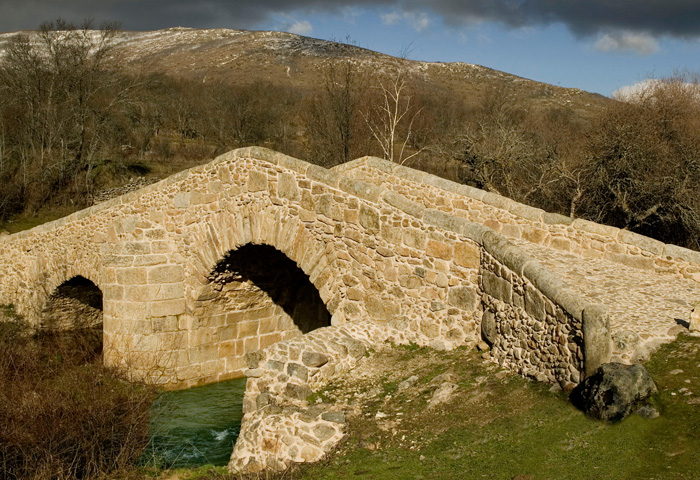Canencia de la sierra
Lozoya town hall
The third medieval bridge in the municipality of Canencia is found downstream of the stream of the same name, almost where it meets the Lozoya River. The point where we cross the Matafrailes bridge, as this bridge is called, corresponds to km 21, indicated in the route Puente del Perdón-El Cuadrón.
The construction is dated between the fourteenth and fifteenth centuries, and its main feature is that its two eyes are asymmetrical. It is preserved in very good condition and recalls the old route that went to Rascafría, marked by bridges of similar characteristics, such as the Congosto or Canto bridge in the municipality of Lozoya, about 10 km away.
At 15′ from the Canto bridge, we find, adjacent to an old flour mill converted into a house, the bridge of Las Cadenas, upstream of the Canencia stream. It is also a medieval construction, has a single span and is gently pointed. Its profile, like that of Puente Canto, is «donkey’s back». The arch was built with slabs of thin, rough and poorly worked stones. It is surrounded by abundant riverside vegetation. Due to its narrow width, it can only be crossed by pedestrians and horses. Its state of conservation and
Canencia twins
The hostal-restaurant Colorines, located in Carencia, offers its guests a wide variety of traditional dishes. Its main specialties are roast kid, suckling pig, lamb, beans, piquillo peppers, chorizo and black pudding.
The municipality was probably used as a hunting ground by the Crown of Castile during the late Middle Ages. In this way, some historians relate the toponym of the town with the dogs (canes), due to the supposed existence of royal kennels in the town.
During the middle of the 18th century, the village, inhabited by more than 100 people, consisted of 232 low and habitable houses, including those of the Council. It had irrigated and dry land, meadows, threshing floors, pools and pastures. It also had flour mills and beehives. The livestock included cattle, mules, horses, sows, sheep, sheep and goats. It had establishments including a tavern, a butcher’s shop, an inn, a hospital and a blacksmith’s shop.
Routes through the mountains of madrid
I had been thinking about the idea of going to Canencia and enjoy its surroundings for some time, and finally it was agreed with a friend. Finally. After almost two and a half months without leaving the big city. I’m going to tell you that the plans did not go as I had thought, but it turned out to be a perfect day because, above all, we wanted to be in nature with as few people around us as possible. We made it and here I tell you about it
The plan was to go directly up to the Puerto de Canencia and do the Ecological Path whose attractions include the Chorrera de Mojonavalle. It is one of the highest waterfalls in the Community of Madrid, and after so much snow and rain I thought it would be good to be filled.
When we got to the top we saw that it was already impossible to park at that time, so without getting out of the car we decided to continue down the road towards the village of Canencia. This village is about nine kilometers downhill curves and best of all: it is not as frequented as the port. I would say that almost nothing frequented.
Canencia de la sierra 2020
The municipality is located in the southern part of the Valle Alto del Lozoya, a territory administratively included in the region of the Sierra Norte. It is located at the foot of the Canencia pass (1524 m altitude), which connects it to the south with Miraflores de la Sierra, through the local road M-629. This road connects, to the north, with the M-604, which crosses longitudinally the upper valley of the Lozoya until it reaches the Northern Highway (A-1).
Its northern boundaries are marked by the municipalities of Lozoya and Gargantilla del Lozoya and Pinilla de Buitrago. To the south it borders with Bustarviejo and Miraflores de la Sierra; to the east with Garganta de los Montes and Valdemanco; and to the west with Pinilla del Valle, Alameda del Valle and Rascafría.
Regarding its flora, its altitudinal range (1150 m above sea level) determines the appearance of extensive meadows and pastures, alternating with oak and holly forests. The Canencia birch grove, of scenic and ecological interest, is located within the municipality. Other plant species include poplar, broom and bramble.
Relacionados

Bienvenid@ a mi blog, soy Octavio Pérez Alonso y te ofrezco noticias de actualidad.

Comments are closed